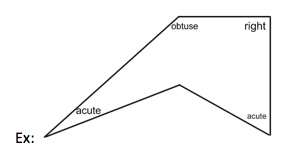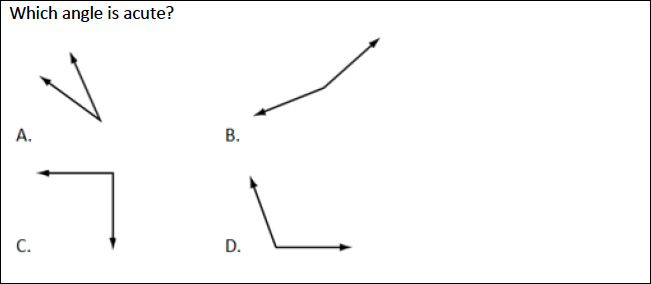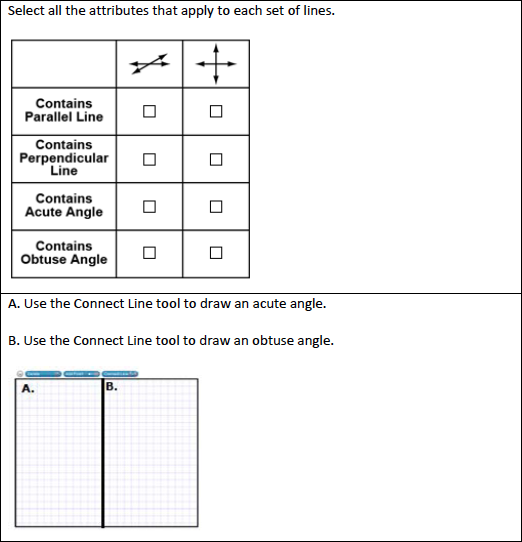Draw points, lines, line segments, rays, angles (right, acute, obtuse), and perpendicular and parallel lines. Identify these in two-dimensional figures.
[divider] [/divider]Students are able to…
- Identify and draw points, lines, line segments, rays, angles (right, acute and obtuse), and perpendicular and parallel lines.
- Use correct mathematical language to describe these shapes.
[divider] [/divider]Students are able to…because teachers…
- Deliver ample opportunities for students to draw, define and compare points, lines, line segments, rays, angles (right, acute and obtuse), and perpendicular and parallel lines.
- Provide manipulatives such as Geoboards or AngLegs for students to build and discuss shapes.
- Direct students to find real-world examples of these shapes throughout the classroom and outside the classroom.
- Support students in their acquisition of new mathematical terminology and definitions.
[divider] [/divider]Questions to ask students:
- Explain the difference between a line, a line segment and a ray.
- Sample answer that indicates understanding: A line is a straight set of points that has no thickness and extends forever in both directions 2. A line segment is part of a line that connects two points 3. A line that starts at a point and goes on forever in one direction.
- Sample answer that indicates an incomplete understanding or a misconception: The students confuses the types of lines or has incomplete definitions.
- What is an example of parallel lines in your classroom? What is an example of perpendicular lines in your classroom? What attributes make them parallel or perpendicular?
- Sample answer that indicates understanding: The border on the bulletin board (the top and bottom layer) are parallel because they will never intersect or cross paths. The side border and bottom border of the bulletin board are perpendicular because they cross paths and create a 90 degree angle.
- Does a square have parallel or perpendicular lines? If so, then identify them.
- Sample answer that indicates understanding: Student identifies that a square has two pair of parallel lines and two pairs of perpendicular lines and can point them out on a square.
- Sample answer that indicates an incomplete understanding or a misconception: The students only identifies one set of lines.
- Draw a shape with at least one acute, one obtuse and one right angle. Label the angles and explain.
[divider] [/divider]FSA Notes
Cognitive Complexity Level: 1: Recall
Achievement Level Descriptors:
2– identifies points, lines, line segments, rays, angles (right, acute, obtuse), and perpendicular and parallel lines
3– draws points, lines, line segments, rays, angles (right,
acute, obtuse), and perpendicular and parallel lines; identifies these in two-dimensional figures
4- draws a figure based on multiple attributes
5– [intentionally left blank]
Assessment Limits:
Items may not require students to name a given figure.
Items may not require knowledge or use of ordered pairs or a defined coordinate grid system.
Items may require students to draw a figure based on multiple attributes (e.g., an acute triangle), with the exception of right triangles.
Items that include trapezoids must consider both the inclusive and exclusive definitions.
Items may not use the term “kite” but may include the figure.
[divider] [/divider]Additional Resources:
Additional in depth content knowledge
Video: Acute, right and obtuse angles
Draw points, lines and line segments
Identify parallel, intersecting, and perpendicular lines
[divider] [/divider]Sample Formative Assessment Tasks:
Resources/Tasks to Help Your Child at Home
Look for examples of the different types of lines in the real-world on the playground, around your home or in books or magazines. Could extend and have your child draw the examples in a journal.
Khan Academy: Parallel & Perpendicular Lines Intro
Identify angles in the real-world environment: As you are in your home, driving, at a store… look for examples of acute, right and obtuse angles. Extend to have your child record and draw the examples of each angle found.
Khan Academy: Acute, Right and Obtuse Angles https://goo.gl/Hp45BT
Khan Academy: Drawing Acute, Right and Obtuse Angles https://goo.gl/WZNT7h



